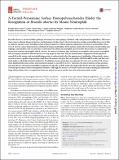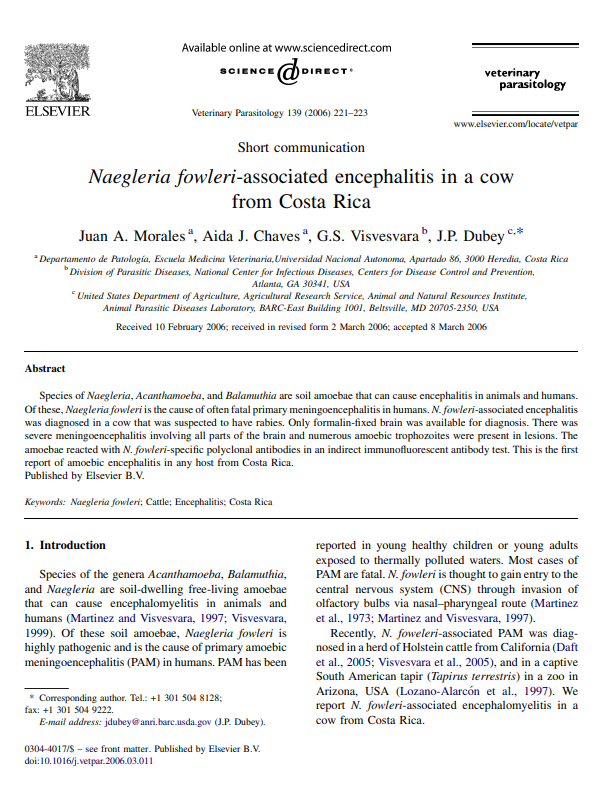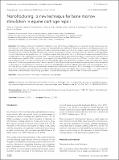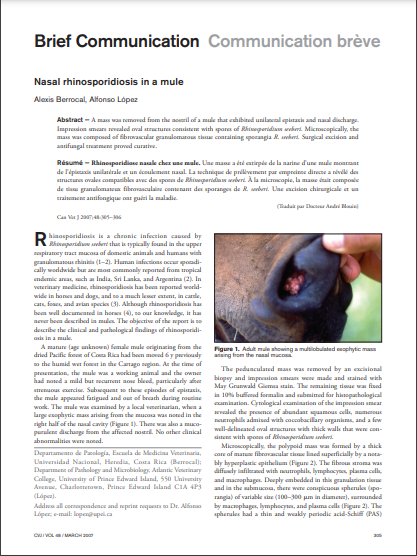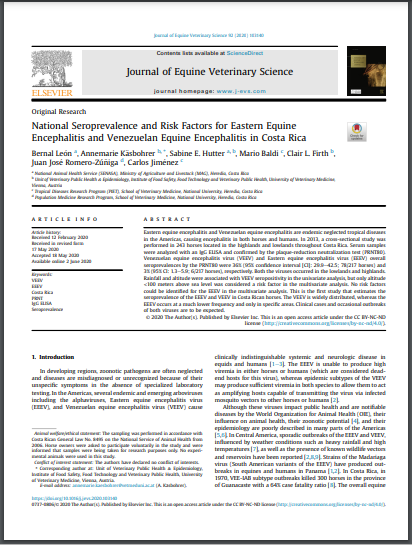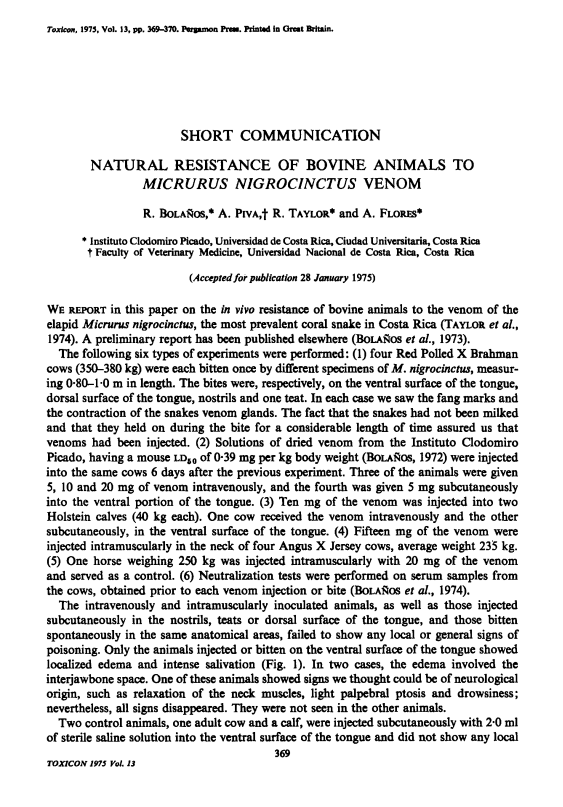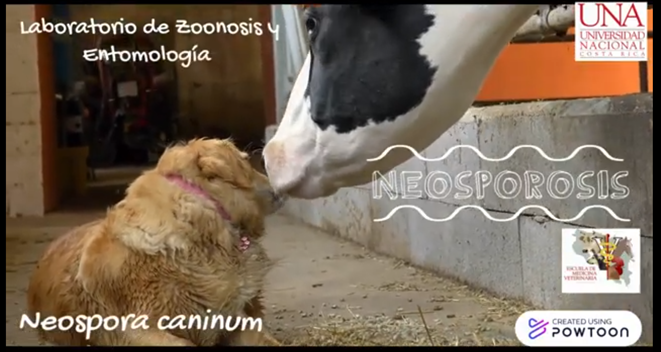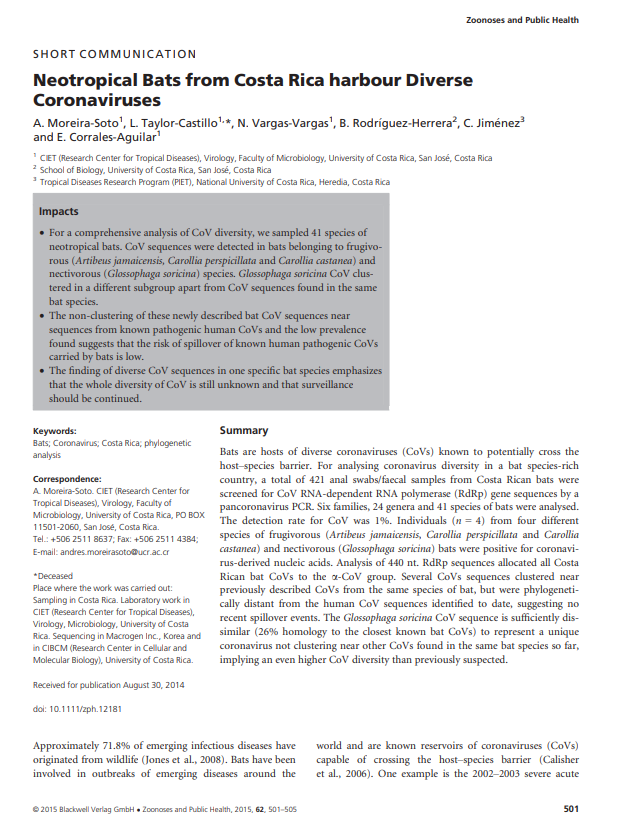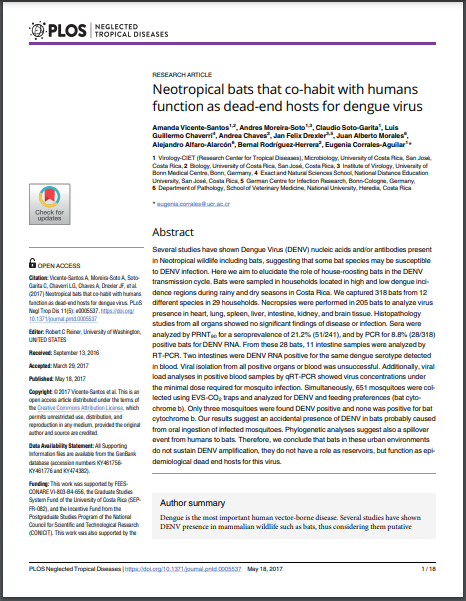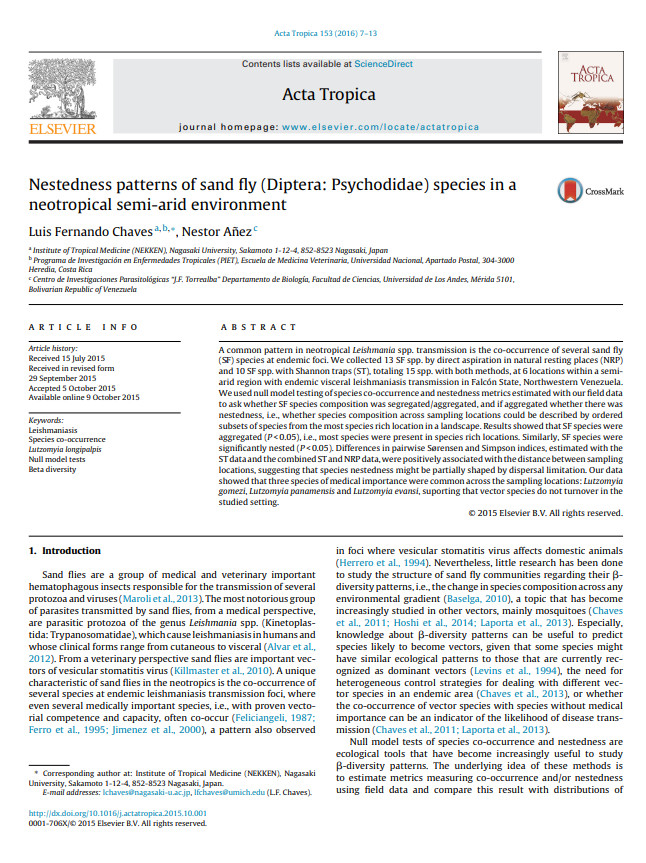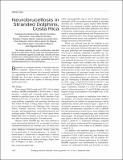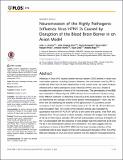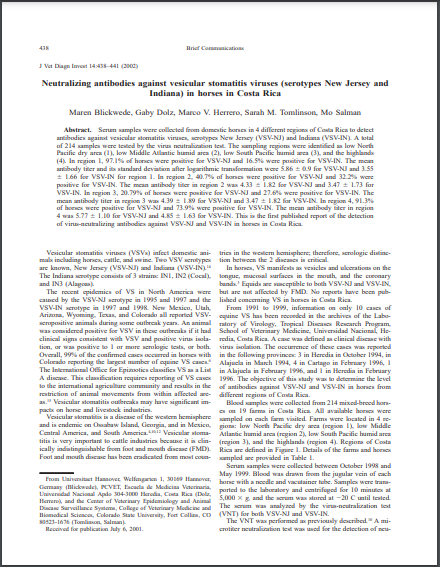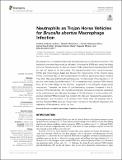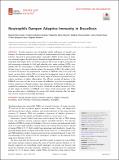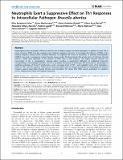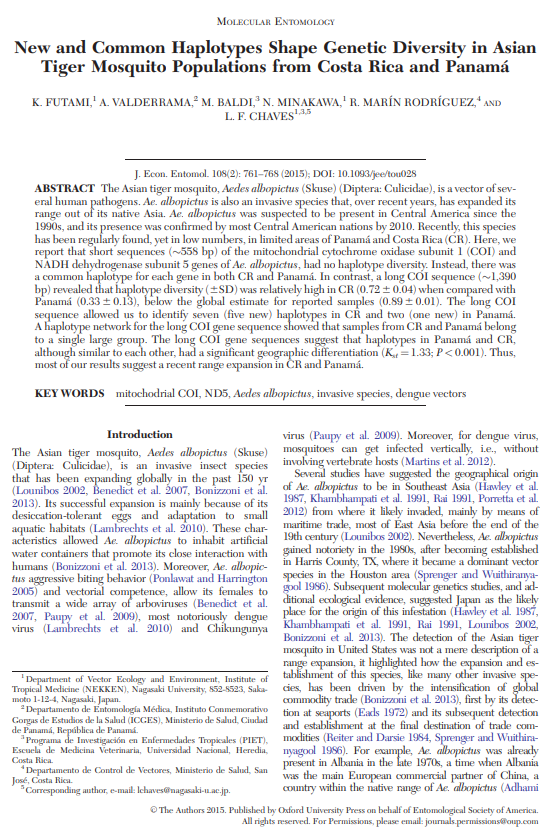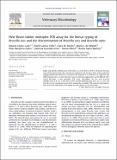Browsing Facultad de Ciencias de la Salud by Title
Now showing items 1076-1095 of 1566
-
N-formyl-perosamine surface homopolysaccharides hinder the recognition of Brucella abortus by mouse neutrophils
(Universidad Nacional, Costa Rica, 2016-06)Brucella abortus is an intracellular pathogen of monocytes, macrophages, dendritic cells, and placental trophoblasts. This bacterium causes a chronic disease in bovines and in humans. In these hosts, the bacterium also ... -
Naegleria fowleri-associated encephalitis in a cow from Costa Rica
(Elsevier, 2006)Species of Naegleria, Acanthamoeba, and Balamuthia are soil amoebae that can cause encephalitis in animals and humans. Of these, Naegleria fowleri is the cause of often fatal primary meningoencephalitis in humans. N. ... -
Nanofracturing: a new technique for bone marrow stimulation in equine cartilage repair
(Pferdeheilkunde, 2020-02-10)Microfracture is the current standard in treatment of focal full-thickness cartilage lesions in horses, but clinical outcome may vary. Nanofracture is a novel technique that uses a commercially developed device to yield ... -
Nasal rhinosporidiosis in a mule
(Canadian Veterinary Medical Association, 2007-03)A mass was removed from the nostril of a mule that exhibited unilateral epistaxis and nasal discharge. Impression smears revealed oval structures consistent with spores of Rhinosporidium seeberi. Microscopically, the mass ... -
National Seroprevalence and Risk Factors for Eastern Equine Encephalitis and Venezuelan Equine Encephalitis in Costa Rica
(Elsevier, 2020-06-02)Eastern equine encephalitis and Venezuelan equine encephalitis are endemic neglected tropical diseases in the Americas, causing encephalitis in both horses and humans. In 2013, a cross-sectional study was performed in ... -
Natural resistance of bovine animals to micrurus nigrocinctus venom
(Elsevier, 1975-11)We Report in this paper on the in vivo resistance of bovine animals to the venom of the elapid Micrttrus nigrocinctas, the most prevalent coral snake in Costa Rica (TAYLOR et al., 1974). Apreliminary report has been published ... -
Neospara caninum
(Universidad Nacional, Costa Rica, 2020-09-05)El objetivo de este vídeo es presentar una breve explicación sobre la neosporosis, enfermedad de origen parasitario y su afección en los animales. Se indican sus consecuencias y alteraciones, formas de transmisión, control, ... -
NEOSPOROSIS
(Universidad Nacional, Costa Rica., 2024-05)La neosporosis es causada por el parásito Neospora caninum. Este es un coccidio intracelular obligado, cuya infección puede darse por vía oral, transplacentaria o transmamaria. En animales sintomáticos es común encontrar ... -
Neotropical bats from Costa Rica harbour diverse coronaviruses
(Blackwell, 2015)Bats are hosts of diverse coronaviruses (CoVs) known to potentially cross the host–species barrier. For analysing coronavirus diversity in a bat species-rich country, a total of 421 anal swabs/faecal samples from Costa ... -
Neotropical bats that co-habit with humans function as dead-end hosts for dengue virus
(Public Library of Science (PLOS), 2017-05-18)Several studies have shown Dengue Virus (DENV) nucleic acids and/or antibodies present in Neotropical wildlife including bats, suggesting that some bat species may be susceptible to DENV infection. Here we aim to elucidate ... -
Nestedness patterns of sand fly (Diptera: Psychodidae) species in a neotropical semi-arid environment
(Elsevier, 2016)A common pattern in neotropical Leishmania spp. transmission is the co-occurrence of several sand fly (SF) species at endemic foci. We collected 13 SF spp. by direct aspiration in natural resting places (NRP) and 10 SF ... -
Neurobrucellosis in stranded dolphins, Costa Rica
(Universidad Nacional, Costa Rica, 2008-09)Ten striped dolphins, Stenella coeruleoalba, stranded along the Costa Rican Pacifi c coast, had meningoencephalitis and antibodies against Brucella spp. Brucella ceti was isolated from cerebrospinal fl uid of 6 dolphins ... -
Neuroinvasion of the highly pathogenic influenza virus H7N1 is caused by disruption of the blood brain barrier in an avian model
(PLOS ONE, 2014-12-15)Influenza A virus (IAV) causes central nervous system (CNS) lesions in avian and mammalian species, including humans. However, the mechanism used by IAV to invade the brain has not been determined. In the current work, we ... -
Neutralizing antibodies against vesicular stomatitis viruses (serotypes New Jersey and Indiana) in horses in Costa Rica
(AAVLD, 2002-09-01)Serum samples were collected from domestic horses in 4 different regions of Costa Rica to detect antibodies against vesicular stomatitis viruses, serotypes New Jersey (VSV-NJ) and Indiana (VSV-IN). A total of 214 samples ... -
Neutrophils as Trojan Horse vehicles for Brucella abortus macrophage infection
(Universidad Nacional, Costa Rica, 2019-05-07)Brucella abortus is a stealthy intracellular bacterial pathogen of animals and humans. This bacterium promotes the premature cell death of neutrophils (PMN) and resists the killing action of these leukocytes. B. abortus-infected ... -
Neutrophils dampen adaptive immunity in Brucellosis
(American Society For Microbiology, 2019-04-23)Brucella organisms are intracellular stealth pathogens of animals and humans. The bacteria overcome the assault of innate immunity at early stages of an infection. Removal of polymorphonuclear neutrophils (PMNs) at the ... -
Neutrophils exert a suppressive effect on Th1 responses to intracellular pathogen Brucella abortus
(PLoS Pathogens, 2013-02-14)Polymorphonuclear neutrophils (PMNs) are the first line of defense against microbial pathogens. In addition to their role in innate immunity, PMNs may also regulate events related to adaptive immunity. To investigate the ... -
New and common haplotypes shape genetic diversity in Asian tiger mosquito populations from Costa Rica and Panama
(Oxford University Press, 2015)The Asian tiger mosquito, Aedes albopictus (Skuse) (Diptera: Culicidae), is a vector of sev eral human pathogens. Ae. albopictus is also an invasive species that, over recent years, has expanded its range out of its native ... -
New Bruce-ladder multiplex PCR assay for the biovar typing of Brucella suis and the discrimination of Brucella suis and Brucella canis
(Veterinary Microbiology, 2011-06-11)Rapid and specific identification of Brucella suis at the biovar level is necessary because some of the biovars that infect animals are pathogenic for humans. None of the molecular typing methods described so far are ... -
New insights into Neutrophil Extracellular Trap (NETs) formation from porcine neutrophils in response to bacterial infections
(MDPI, 2022-08-11)Actinobacillus pleuropneumoniae (A.pp, Gram negative) and Streptococcus (S.) suis (Gram positive) can cause severe diseases in pigs. During infection, neutrophils infiltrate to counteract these pathogens with phagocytosis ...

